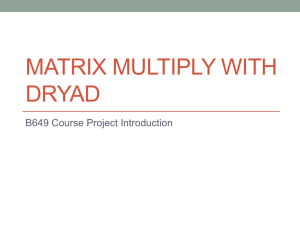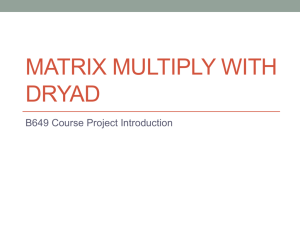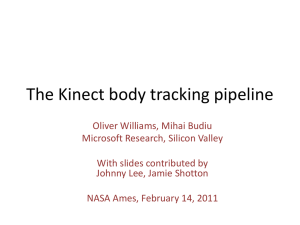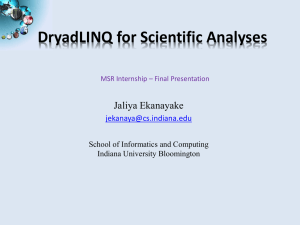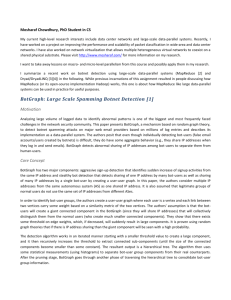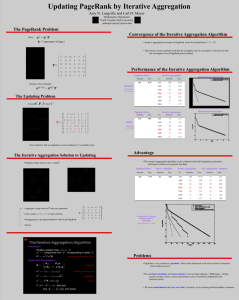Design Patterns for Scientific Applications in DryadLINQ CTP ABSTRACT
advertisement
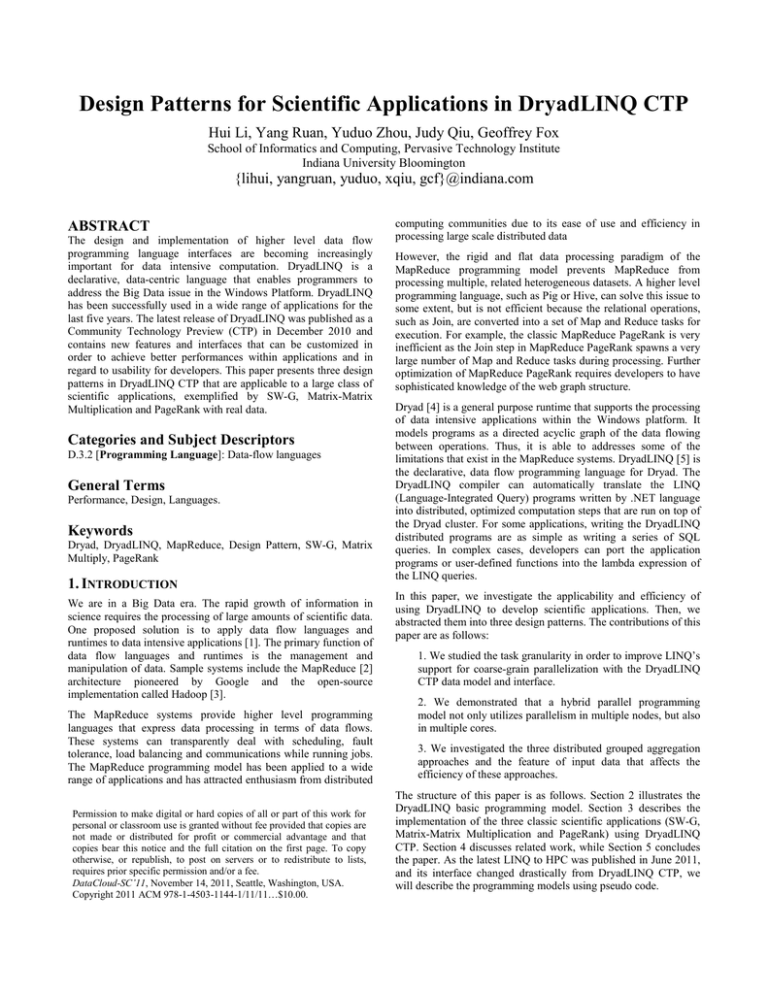
Design Patterns for Scientific Applications in DryadLINQ CTP
Hui Li, Yang Ruan, Yuduo Zhou, Judy Qiu, Geoffrey Fox
School of Informatics and Computing, Pervasive Technology Institute
Indiana University Bloomington
{lihui, yangruan, yuduo, xqiu, gcf}@indiana.com
ABSTRACT
The design and implementation of higher level data flow
programming language interfaces are becoming increasingly
important for data intensive computation. DryadLINQ is a
declarative, data-centric language that enables programmers to
address the Big Data issue in the Windows Platform. DryadLINQ
has been successfully used in a wide range of applications for the
last five years. The latest release of DryadLINQ was published as a
Community Technology Preview (CTP) in December 2010 and
contains new features and interfaces that can be customized in
order to achieve better performances within applications and in
regard to usability for developers. This paper presents three design
patterns in DryadLINQ CTP that are applicable to a large class of
scientific applications, exemplified by SW-G, Matrix-Matrix
Multiplication and PageRank with real data.
Categories and Subject Descriptors
D.3.2 [Programming Language]: Data-flow languages
General Terms
Performance, Design, Languages.
Keywords
Dryad, DryadLINQ, MapReduce, Design Pattern, SW-G, Matrix
Multiply, PageRank
1. INTRODUCTION
We are in a Big Data era. The rapid growth of information in
science requires the processing of large amounts of scientific data.
One proposed solution is to apply data flow languages and
runtimes to data intensive applications [1]. The primary function of
data flow languages and runtimes is the management and
manipulation of data. Sample systems include the MapReduce [2]
architecture pioneered by Google and the open-source
implementation called Hadoop [3].
The MapReduce systems provide higher level programming
languages that express data processing in terms of data flows.
These systems can transparently deal with scheduling, fault
tolerance, load balancing and communications while running jobs.
The MapReduce programming model has been applied to a wide
range of applications and has attracted enthusiasm from distributed
Permission to make digital or hard copies of all or part of this work for
personal or classroom use is granted without fee provided that copies are
not made or distributed for profit or commercial advantage and that
copies bear this notice and the full citation on the first page. To copy
otherwise, or republish, to post on servers or to redistribute to lists,
requires prior specific permission and/or a fee.
DataCloud-SC’11, November 14, 2011, Seattle, Washington, USA.
Copyright 2011 ACM 978-1-4503-1144-1/11/11…$10.00.
computing communities due to its ease of use and efficiency in
processing large scale distributed data
However, the rigid and flat data processing paradigm of the
MapReduce programming model prevents MapReduce from
processing multiple, related heterogeneous datasets. A higher level
programming language, such as Pig or Hive, can solve this issue to
some extent, but is not efficient because the relational operations,
such as Join, are converted into a set of Map and Reduce tasks for
execution. For example, the classic MapReduce PageRank is very
inefficient as the Join step in MapReduce PageRank spawns a very
large number of Map and Reduce tasks during processing. Further
optimization of MapReduce PageRank requires developers to have
sophisticated knowledge of the web graph structure.
Dryad [4] is a general purpose runtime that supports the processing
of data intensive applications within the Windows platform. It
models programs as a directed acyclic graph of the data flowing
between operations. Thus, it is able to addresses some of the
limitations that exist in the MapReduce systems. DryadLINQ [5] is
the declarative, data flow programming language for Dryad. The
DryadLINQ compiler can automatically translate the LINQ
(Language-Integrated Query) programs written by .NET language
into distributed, optimized computation steps that are run on top of
the Dryad cluster. For some applications, writing the DryadLINQ
distributed programs are as simple as writing a series of SQL
queries. In complex cases, developers can port the application
programs or user-defined functions into the lambda expression of
the LINQ queries.
In this paper, we investigate the applicability and efficiency of
using DryadLINQ to develop scientific applications. Then, we
abstracted them into three design patterns. The contributions of this
paper are as follows:
1. We studied the task granularity in order to improve LINQ’s
support for coarse-grain parallelization with the DryadLINQ
CTP data model and interface.
2. We demonstrated that a hybrid parallel programming
model not only utilizes parallelism in multiple nodes, but also
in multiple cores.
3. We investigated the three distributed grouped aggregation
approaches and the feature of input data that affects the
efficiency of these approaches.
The structure of this paper is as follows. Section 2 illustrates the
DryadLINQ basic programming model. Section 3 describes the
implementation of the three classic scientific applications (SW-G,
Matrix-Matrix Multiplication and PageRank) using DryadLINQ
CTP. Section 4 discusses related work, while Section 5 concludes
the paper. As the latest LINQ to HPC was published in June 2011,
and its interface changed drastically from DryadLINQ CTP, we
will describe the programming models using pseudo code.
2. DRYADLINQ PROGRAMMING MODEL
Dryad, DryadLINQ and DSC [6] are a set of technologies that
support the processing of data intensive applications in the
Windows platform. The software stack for these technologies is
shown in Figure 1.
Dryad is a general purpose runtime that supports the processing of
data intensive applications in Windows platform. A Dryad job is
represented as a directed acyclic graph (DAG), which is called the
Dryad graph. One Dryad graph consists of vertices and channels. A
graph vertex is an independent instance of the data processing
program in a certain step. Graph edges are the channels
transferring data between the vertices. The Distributed Storage
Catalog (DSC) is the component that works with the NTFS in
order to provide data management functionalities, such as data sets
storage, replication and load balancing within the HPC cluster.
DryadLINQ is a high level programming language and compiler
for Dryad. The DryadLINQ API is based on the LINQ
programming model. It takes advantage of the standard query
operators defined within the LINQ and adds query extensions
specific to Dryad. Developers can easily apply LINQ operators,
such as Join or GroupBy, to a set of .NET data objects, which
increase the speed of the development of the data intensive
applications.
Fig.1: Software Stack for DryadLINQ CTP
//Construct DryadLINQ Distributed Data Objects--inputs
Var outputs= inputs.Select(distributedObject =>
User_Defined_Function(distributedObject));
//Process DryadLINQ Distributed Data Objects with UDF
A wide range of pleasingly parallel applications can be
implemented using the above DryadLINQ primitives [7], which
include the CAP3 DNA sequence assembly application, High
Energy Physics data analysis application and the all pair gene
sequences SW-G computation.
2.2. Hybrid Parallel Programming Model
Dryad is supposed to process coarse-granularity tasks for large
scale distributed data. It usually schedules tasks for the resources
in the unit of compute nodes rather than the cores. In order to
increase the utilization of the multi-core Windows cluster, one
direct approach is to invoke PLINQ (parallel LINQ) queries within
the lambda expression of the DryadLINQ query. This approach is
not only convenient, but, also, efficient as the LINQ query is
naturally built within the DryadLINQ query. The other approach is
to apply the multi-core technologies in .NET, such as TPL, and the
thread pool to the user-defined function within in lambda
expression of the DryadLINQ query. The pseudo code for this
programming model is as follows:
Var inputs= inputDataSet.AsDistributedFromPartitions();
//Construct DryadLINQ Distributed Data Objects--inputs
Var outputs =
inputs.ApplyPerPartition(distributedObject =>
distributedObject.AsParallel().Select(parallelObject=>
User_Defined_Function(parallelObject)));
//Process DryadLINQ Distributed Data Object with PLINQ
In the above hybrid model, Dryad handles the parallelism between
the cluster nodes, while the PLINQ, TPL and thread pool
technologies deal with the parallelism on the multi-core of each
node. The hybrid parallel programming model in
Dryad/DryadLINQ has been proven to be successful and has been
applied to data clustering applications [7], such as the GTM
interpolation and MDS interpolation. Most of the pleasingly
parallel applications can be implemented using this model.
2.3. Distributed Grouped Aggregation
2.1. Pleasingly Parallel Programming Model
Many pleasingly parallel applications are of the Single Program
Multiple Data (SPMD) model. DryadLINQ supports a unified data
and programming model in the representation and processing of
pleasingly parallel applications. DryadLINQ data objects are
collections of strong .NET type objects, which can be split into
partitions and distributed across cluster. These DryadLINQ data
objects
are
represented
as
DistributedQuery<T>
or
DistributedData<T> objects to which the LINQ operators can
apply. DryadLINQ applications can create the DistributeData<T>
objects from the existing data stored in the DSC or convert it from
the IEnumerable<T> objects using AsDistributed() and
AsDistributedFromPartitions() operators. Then, these DryadLINQ
data objects are partitioned and distributed to the nodes.
Developers can deal with these distributed DryadLINQ data
objects by invoking the user-defined function within the Select() or
ApplyPerPartition() operators. The pseudo code for this
programming model is as follows:
Var inputs= inputDataSet.AsDistributedFromPartitions();
The GROUP BY operator in the parallel database is often followed
by the aggregate function, which groups the input records into
partitions by keys and then merges the records for each group
using certain attribute values. This common pattern is called the
distributed grouped aggregation. Sample applications for this
pattern include sales data summarizations, log data analysis and
social network influence analysis [8] [9].
Several approaches exist by which to implement the distributed
grouped aggregation. A direct approach is to use the hash partition
operator to redistribute the records to the compute nodes so that
identical records are stored on the same node. After that this
approach merges the records of each group on each node.
The implementation of the hash partition is simple, but creates a
large amount of network traffic when the number of input records
is very large. A common way to optimize this approach is to apply
pre-aggregation, which aggregates the local records of each node
and then hash partitions the aggregated partial results across a
cluster based on their key. This approach is better than the direct
hash partition because the number of records transferred across the
cluster becomes much smaller after the local aggregation
operation.
Two additional ways exist by which to implement the preaggregation: 1) hierarchical aggregation and 2) an aggregation tree
[10]. A hierarchical aggregation usually contains two or three
aggregation layers, each having an explicit synchronization phase.
An aggregation tree is a tree graph that guides a job manager to
perform the pre-aggregation for the many subsets of the input
records. The workflow of the three distributed grouped aggregation
approaches is shown in Figure 2.
3.1.Pleasingly Parallel Application
The Alu clustering problem [11] [12] is one of the most challenging
problems when sequencing clustering because Alus represent the
largest repeat families in the human genome. About one million
copies of the Alu sequence exist in the human genome. Most
insertions can be found in other primates and only a small fraction
(~7000) are human-specific. This feature indicates that the
classification of Alu repeats can be deduced solely from the one
million human Alu elements. Notably, Alu clustering can be viewed
as a classical case study for the capacity of computational
infrastructures because it is not only of intrinsic biological interest,
but, also, a problem on a scale that will remain as the upper limit of
many other clustering problems in bioinformatics for the next few
years, e.g. the automated protein family classification for a few
million proteins predicted from large meta-genomics projects.
Fig. 3: DryadLINQ Implementation of SW-G Application
Fig. 2: Three Distributed Grouped Aggregation Approaches: Hash
Partition, Hierarchical Aggregation, and Aggregation Tree.
3. IMPLEMENTATIONS
We implemented SW-G, Matrix-Matrix Multiplication and
PageRank using the DryadLINQ CTP and then evaluated their
performances on two Windows HPC clusters and one Linux
cluster. The hardware resources used in this paper are as follows:
Table 1: 32 Nodes Homogeneous HPC Cluster TEMPEST
CPU
TEMPEST
TEMPEST-CNXX
Intel E7450
Intel E7450
Cores
24
24
Memory
24.0 GB
50.0 GB
Memory/Core
1 GB
2 GB
Table 2: 7 Nodes Inhomogeneous HPC Cluster STORM
CPU
Cores
Memory
Memory/Core
STORMCN01,CN02,
CN03
AMD 2356
8
16 GB
2 GB
STORMCN04,CN05
STORMCN06,CN07
AMD 8356
16
16 GB
1 GB
Intel E7450
24
48 GB
2 GB
Table 3: 230 Nodes Homogeneous Linux Cluster Quarry
CPU
Cores
Memory
Memory/Core
Head Node
Intel E5335
8
8 GB
1 GB
PG-XX
Intel E5335
8
16 GB
2
GB
We implemented the DryadLINQ application in order to calculate
the pairwise SW-G distances in parallel for a given set of gene
sequences. In order to clarify our algorithm, we considered an
example with 10,000 gene sequences, which produced a pairwise
distance matrix of 10,000 × 10,000. We decomposed the overall
computation into a block matrix D of 8 × 8, each block containing
1250 × 1250 sequences. Due to the symmetry of the distances D(i,j)
and D(j,i), we only calculated the distances in the 36 blocks of the
upper triangle of the block matrix as shown in Figure 3. These 36
blocks were constructed as 36 DryadLINQ distributed data objects.
Then, our program split the 36 DryadLINQ objects into 6 partitions,
which spawned 6 DryadLINQ tasks. Each Dryad task invoked the
user-defined function PerformAlignments() in order to process the
six blocks that were dispatched to each Dryad task. One should bear
in mind that different partition scheme will cause different task
granularity. The DryadLINQ developers can control task
granularity by simply specify the number of partition with
RangePartition() operator.
3.1.1.
Workload Balance for Inhomogeneous Tasks
The workload balance is a common issue when scheduling
inhomogeneous tasks on homogeneous resources or vice versa. In
order to solve this issue, Dryad provides a unified data model and
flexible interface for developers to tune task granularity. The
following experiments will study workload balance issue in
DryadLINQ SW-G application.
The SW-G is a pleasingly parallel application, but the pairwise
SW-G computations are inhomogeneous in CPU time. The task of
splitting all of the SW-G blocks into partitions with an even
number of blocks still experiences a workload balance issue when
processing the partitions on the homogeneous computational
resources. One approach for this issue is to split the skewed
distributed input data into many finer granularity tasks. In order to
verify this approach, we constructed a set of gene sequences with a
Execution Time (Seconds)
10000
9000
8000
7000
6000
5000
4000
3000
2000
Std. Dev. = 50
Std. Dev. = 100
Std. Dev. = 250
1000
0
31
62
124
186
248
Number of Partitions
Fig. 4: Performance Comparison for Skewed Distributed Data with
Different Task Granularity.
3.1.2.
Workload Balance for Inhomogeneous Cluster
Clustering or extending existing hardware resources may lead to
the problem of scheduling tasks on an inhomogeneous cluster with
different CPUs, memory and network capabilities between nodes
[13]. Allocating the workload to resources according to their
computational capability is a solution, but requires the runtimes to
know the resource requirement of each job and availability of
hardware resources. Another solution is to split the entire job into
many finer granularity tasks and dispatch available tasks to idle
computational resources.
partitions: 6, 24 and 192. In the first SW-G job, the entire job was
split into six partitions. The difference in CPU time for each task
was caused by the difference in the computational capability of the
nodes. The second and third jobs in Figure 5 clearly illustrate that
finer partition granularity can deliver a better load balance on the
inhomogeneous computational nodes. However, it also showed
that the task scheduling cost increased as the number of partitions
increased.
3.1.3.
Compare with Hadoop
As shown in Figures 4 and 5, the task granularity is important for
the workload balance issue in DryadLINQ. Further, we compared
the task granularity issue of DryadLINQ with that of Hadoop. The
DryadLINQ/PLINQ SW-G experiments were run with 24 cores per
node on 32 nodes in TEMPEST. The input data was 10,000 gene
sequences. The number of DryadLINQ tasks per vertex ranged
from 1 to 32. The Hadoop SW-G experiments were run with 8
cores per node on 32 nodes in Quarry. Eight mappers and one
reducer were deployed on each node. The number of map tasks per
mapper ranged from 1 to 32. As shown in Figure 6, when the
number of tasks per vertex was bigger than 8, the relative parallel
efficiency of DryadLINQ jobs decreased noticeably. This decrease
occurred because the number of tasks per vertex was bigger than 8
and the number of SW-G blocks allocated to each DryadLINQ task
was less than 12, which is only half of the number of cores in each
node in TEMPEST. Dryad can run only one DryadLINQ task on
each compute node. Thus the relative parallel efficiency was low
for fine task granularity in DryadLINQ.
Hadoop -- Tasks per Mapper
Relative Parallel Efficiency
given mean sequence length (400) using varying standard
deviations (50, 150, 250). Then, we ran the SW-G dataset on the
TEMPEST cluster using a different number of data partitions. As
shown in Figure 4, as the number of partitions increased, the
overall job turnaround time decreased for the three skewed
distributed input datasets. This phenomenon occurs because the
finer granularity tasks can achieve the better overall system
utilization by dynamically dispatching available tasks to idle
resources. However, when the number of partitions continually
increases, the scheduling costs become the dominant factor in
regard to overall performance.
DryadLINQ -- Tasks per Vertex
1.2
1
0.8
0.6
0.4
0.2
1200
0
0
4
8
12
16
20
24
28
32
Number of Tasks per Worker
1000
Elapsed Time (in second)
Fig. 6: Relative Parallel Efficiency of Hadoop and DryadLINQ with
Different Task Granularity.
800
3.2. Hybrid Parallel Programming Model
600
In order to explore the hybrid parallel programming model, we
implemented the DryadLINQ Matrix-Matrix Multiplication using
three algorithms and three multi-core technologies. The three
matrix multiplication algorithms were: 1) row partition algorithm,
2) row/column partition algorithm and 3) two dimension block
decomposition in the Fox algorithm [14]. The multi-core
technologies were: 1) PLINQ, 2) TPL, and 3) Thread Pool.
400
200
6 partitions
192 partitions
24 partitions
cn06
cn05
cn04
cn03
cn02
cn01
cn06
cn05
cn04
cn03
cn02
cn01
cn01
cn02
cn03
cn04
cn05
cn06
0
Fig. 5: CPU and Scheduling Time of the Same SW-G Job with
Various Partition Granularities
We verified the second approach by executing 4,096 sequences
for SW-G jobs on the inhomogeneous HPC STORM using
different partition granularities. Figure 5 shows the CPU and task
scheduling times of the same SW-G job with a different number of
3.2.1.
Matrix-Matrix Multiplication Algorithms
The row partition algorithm split matrix A by rows. It scattered the
rows of the blocks of matrix A across the compute nodes, and then
copied all of matrix B to every compute node. Each Dryad task
multiplied some of the rows of the blocks of matrix A by the entire
matrix B, and then retrieved the partial output results to the main
program and added these results to the corresponding rows of
blocks of matrix C.
The two dimensional block decomposition in the Fox algorithm is
called the Broadcast-Multiply-Roll (BMR) algorithm. In the initial
stage of the Fox algorithm, it splits matrix A and matrix B into
squared sub-matrices. These sub-matrices were scattered into a
square mesh of processors. Figure 7 is the work flow of the Fox
algorithm on a mesh of 2*2 nodes.
RowColumnPartition algorithm performed worse than the
RowPartition as it had additional startup costs in the multiple steps.
3.2.2.
Parallelism in the Core Level
We evaluated the multi-core technologies in .NET 4 by running
matrix-matrix multiplication jobs with various matrices sizes whose
scales ranged from 2,400 * 2,400 to 19,200 * 19,200 on a 24-core
machine. Figure 9 shows the performance results for the three
multi-core technologies. As illustrated in Figure 9, the PLINQ had
the best performance compared to the other technologies.
PLINQ
1.2
ParallEl Efficiency
The row/column partition algorithm [15] split matrix A into rows
and matrix B into columns. The column blocks of matrix B were
scattered across the cluster in advance. Then, the entire
computation was divided into several steps. In each step, one task
multiplied one row of blocks of matrix A by one column of blocks
of matrix B on the compute node. The output results were sent
back to the main program and aggregated into one row of blocks of
matrix C. The main program collected the results in all of the steps
in order to generate the final results of matrix C.
TPL
Thread
1
0.8
0.6
0.4
0.2
0
2400 4800 7200 9600 12000 14400 16800 19200
Matrix Sizes
Fig. 9: Parallel Efficiency for Different Technologies of Multi-Core
Parallelism on the 24 Core Compute Node
3.2.3.
Relative Parallel Efficiency
We evaluated the three algorithms by running matrix
multiplication jobs with various matrices sizes whose scales ranged
from 2,400 to 19,200. By default, we used a square matrix in the
experiments and the elements of the matrices were double
numbers. The experiments were run with one core per node on the
16 compute nodes in TEMPEST.
2
Fox-Hey
RowPartition
RowColumnPartition
1.5
1
0.5
0
2400 4800 7200 9600 12000 14400 16800 19200
Matrix Sizes
Fig. 8: Relative Parallel Efficiency of the Three Algorithms
As shown in Figure 8, the Fox algorithm performed better than the
other two algorithms for the large matrices. The RowPartition
algorithm had the simplest logic and least amount of scheduling
costs. It did not perform as well as the Fox algorithm due to the fact
that it did not parallelize the communications when broadcasting
matrix A and scattering sub-matrices B over the cluster. The
Relative Parallel Efficiency
Fig. 7: Work Flow of the Fox Algorithm on a Mesh of 2*2 Nodes
Porting Multi-core Tech into Dryad Tasks
We investigated the overall performance of the three matrix
multiplication algorithms when porting PLINQ to the DryadLINQ
tasks. The experiments were run with 24 cores per node on 16
nodes in TEMPEST. The matrices sizes ranged from 2,400 * 2,400
to 19,200 * 19,200. As shown in Figure 9 and 10, 1) the PLINQ
version was much faster than the sequential version, 2) each of the
three algorithms scaled out for the large matrices and 3) the Fox
algorithm performed better than the other algorithms for the large
matrices.
0.7
Fox-Hey
RowPartition
RowColumnPartition
0.6
0.5
0.4
0.3
0.2
0.1
0
2400 4800 7200 9600 12000 14400 16800 19200
Matrices Sizes
Fig. 10: Relative Parallel Efficiency for the PLINQ Version of the
Three Matrix Multiplication Algorithms
3.2.4.
Compare with OpenMPI and Twister
We compared the scalability of the Fox algorithm of
DryadLINQ/PLINQ with that of the OpenMPI/Pthread and
Twister/Thread. The DryadLINQ experiments were run with 24
cores per node on 16 nodes in TEMPEST. The OpenMPI and
Twister experiments were run with 8 cores per node on 16 nodes in
Quarry. The matrices sizes ranged from 2,400*2,400 to
31,200*31,200. As shown in Figure 11, the parallel efficiency of
the Fox algorithm of the DryadLINQ/PLINQ was smaller than that
of the OpenMPI/Pthread and Twister/Thread for the small matrices
sizes. The super linear speed up in Twister is due to the cache
behaving better in the parallel case. The experiment results also
indicate that the DryadLINQ implementation is able to scale out
for large matrices.
DryadLINQ/PLINQ
OpenMPI/Pthread
Twister/Thread
1.2
Second, we implemented PageRank using the hierarchical
aggregation approach, which has tree fixed aggregation stages: 1)
the first pre-aggregation stage for each user-defined aggregation
function, 2) the second pre-aggregation stage for each DryadLINQ
partition and 3) the third global aggregation stage to calculate the
global PageRank rank values.
1
0.8
0.6
0.4
0.2
0
Matrices Sizes
Fig. 11: Parallel Efficiency of the Fox Algorithm Using the
DryadLINQ/PLINQ, OpenMPI/Pthread and Twister/Thread
3.3. Distributed Grouped Aggregation
We studied the distributed grouped aggregation in the DryadLINQ
CTP using PageRank with real data. Specifically, we investigated
the programming interface and performance of the three distributed
grouped aggregation approaches in the DryadLINQ, which included
the Hash Partition, Hierarchical Aggregation and Aggregation Tree.
Further, we studied the features of the input data that affected the
performance
of
the
distributed
grouped
aggregation
implementations.
PageRank is already a well-studied web graph ranking algorithm. It
calculates the numerical value of each element of a hyperlinked set
of web pages in order to reflect the probability that a random surfer
will access those pages. The PageRank process can be understood
as a Markov Chain, which needs recursive calculations in order to
converge to the final results. An iteration of the algorithm calculates
the new access probability for each web page based on the values
calculated in the previous computation. The iterations will not stop
until the Euclidian distance between the two subsequent rank value
vectors becomes less than a predefined threshold. In this paper, we
implemented the DryadLINQ PageRank using the ClueWeb09
dataset [16], which contained almost 50 million web pages.
We split the entire ClueWeb graph into 1,280 partitions, each
saved as an Adjacency Matrix (AM) file. The characteristics of the
input data are described below:
No of Am Files
File Size
No of Web Pages
No of Links
Ave Out-degree
1280
9.7 GB
49.5 million
1.40 billion
29.3
3.3.1.
PageRank using Three Distributed Grouped
Aggregation Approaches
The hierarchical aggregation approach may not perform well in the
computation environment which is inhomogeneous in network
bandwidth, CPU and memory capability due to the existence of its
global synchronization stages. In this scenario, the aggregation tree
approach is a better choice. It can construct a tree graph in order to
guide the job manager to make the optimal aggregation operations
for many of the subsets of the input tuples so as to decrease the
intermediate data transformation. We implemented PageRank using
the
aggregation
tree
approach
by
invoking
the
GroupAndAggregate() operator in DryadLINQ CTP [10].
3.3.2.
Performance Analysis
We evaluated the performance of the three approaches by running
PageRank jobs using various sizes of input data on 17 compute
nodes on TEMPEST. Figure 12 shows that the aggregation tree and
hierarchical aggregation approaches outperformed the hash partition
approach. In the ClueWeb dataset, the URLs are stored in
alphabetical order and the web pages that belong to the same
domain are likely to be saved in one AM file. Thus, the
intermediate data transfer in the hash partition stage can be greatly
reduced by applying the pre-aggregation to each AM file. The
hierarchical aggregation approach outperforms the aggregation tree
approach because it has a coarser granularity processing unit. In
addition, our experiment environment for the TEMPEST cluster has
a homogeneous network and CPU capability.
250
200
Second per Iteration
Relative Parallel Efficiency
1.4
DistributedQuery<Rank> objects each of which represent a pair
that contains the identifier number of a page and its current
estimated rank value. After that, the program joins the pages within
the ranks in order to calculate the partial rank values. Then, the
GroupBy() operator hash partition calculated the partial rank
values to some groups, where each group represented a set of
partial ranks with the same source page pointing to them. At last,
the partial rank values in each group were aggregated using the
user-defined aggregation function.
150
100
50
Aggregation Tree
Hash Partition
Hierarchical Aggregation
0
320
480
640
800
Number of AM files
960
1120
1280
PageRank is a communication intensive application that requires
joining two input data streams and then performing the grouped
aggregation over partial results.
Fig. 12: PageRank Execution Time per Iteration with Three
Aggregation Approaches on 17 Nodes
First, we implemented PageRank with the hash partition approach
with three main functions [17]: Join(), GroupBy(), and userdefined aggregation function. In the Join stage, we constructed the
DistributedQuery<Page> objects that represented the web graph
structure of the AM files. Then, we constructed the
In general, the pre-aggregation approaches work well only when
the number of output tuples is much smaller than the input tuples.
The hash partition works well only when the number of output
tuples is larger than the input tuples. We designed a mathematics
model in order to theoretically analyze how the ratio between the
𝐷𝑅𝑃 =
𝑛𝑢𝑚𝑏𝑒𝑟 𝑜𝑓 𝑜𝑢𝑡𝑝𝑢𝑡 𝑡𝑢𝑝𝑙𝑒𝑠
𝑛𝑢𝑚𝑏𝑒𝑟 𝑜𝑓 𝑖𝑛𝑝𝑢𝑡 𝑡𝑢𝑝𝑙𝑒𝑠
(1)
Table 4: Data Reduction Ratios for Different PageRank
Approaches with the Clueweb09 Dataset
Input Size
Hash
Aggregation
1:306
1:389
1:587
320 files 2.3 GB
640 files 5.1 GB
1,280 files 9.7G
Preaggregation
1:6.6:306
1:7.9:389
1:11.8:587
Hierarchical
Aggregation
1:6.6:2.1:306
1:7.9:2.3:389
1:11.8:3.7:587
Further, we defined a mathematic model to describe how the DRP
will affect the efficiency of different aggregation approaches. First,
we assumed that the average number of tuples for each group is M
(M=1/DRP) and that there are N compute nodes. Then, we
assumed that the M tuples of each group are evenly distributed on
the N nodes. In the hash partition approach, the M tuples with the
same key are hashed into the same group on one node, which
require M aggregation operations. In the pre-aggregation
approaches, the number of local aggregation operations is M/N on
each node, which produces N partial aggregated results and need N
more aggregation operations. Thus, the total number of
aggregation operations for the M tuples is (M/N)*N+N. Then, the
average number of aggregation operations for each record of the
two approaches is as follows:
�
𝑂�
𝑀
𝑀
� = 𝑂(1 + 𝑁 ∗ 𝐷𝑅𝑃)
(2)
Usually, DRP is much smaller than the number of compute nodes.
Taking word count as an example, documents with millions of
words may have several thousands common words. As the web
graph structure obeys zipf’s law, the DRP of the PageRank input
data was not as small as the DRP in regard to word count. Thus, the
pre-aggregation approach in PageRank may not deliver
performance as well as word count [10].
Hash Partition
3.3.3.
Compare with Other Runtimes
We compared the performance of the distributed grouped
aggregation of DryadLINQ with OpenMPI [19], Twister [20],
Hadoop, and Haloop [21]. We implemented PageRank using these
five runtimes for the ClueWeb09 dataset with the Power method
[22]. The DryadLINQ experiments were run with 24 cores per
node on 16 nodes in TEMPEST. The MPI, Twister, Hadoop, and
Haloop experiments were run with 8 cores per node on 16 nodes in
Quarry.
6%
5%
MPI
4%
Twister
Haloop
3%
Dryad
2%
Hadoop
1%
0%
PageRank using 5 Different Runtimes
Fig 14 Parallel Efficiency of Five PageRank Implementation
𝑀
𝑂 � � = 𝑂(1)
𝑀+𝑁
tuples. Figure 13 shows the time per iteration of the PageRank jobs
for serial datasets whose output tuples ranged from 100,000 to
1000,000 while input tuples were fixed at 4.3 billion. As shown in
Figure 13, different grouped aggregation approaches fit well with
different DRP range of input data.
Parallel Efficiency
input and output tuples affected the performance of the aggregation
approaches. First, we defined the data reduction proportion (DRP)
[18] in order to describe the ratio as follows:
Aggregation Tree
1200
1100
1000
900
800
700
600
500
400
300
As shown in Figure 14, the parallel efficiency of the PageRank jobs
was noticeably smaller than 1%. The first reason is that PageRank
is a communication intensive application, and the computation does
not use a large proportion of the overall PageRank job turnaround
time. Second, using multi-core technology does not help to increase
parallel efficiency; instead it decreases overall parallel efficiency.
The MPI, Twister and Haloop implementations outperformed the
DryadLINQ implementations, because they could cache loopinvariable data or static data in the memory in multiple iterations.
Dryad and Hadoop were slower than the other approaches, as their
intermediate results were transferred via distributed file systems.
4. RELATED WORK
Second Per Itreation
4.1. Pleasingly Parallel Application
Num of Output Tuples
Fig. 13: Execution Time for Two Aggregation Approaches with
Different DRP Values.
In order to quantitatively analysis how the DRP affected the
aggregation performance, we compared the two aggregation
approaches using a set of web graphs with different DRPs by fixing
the number of output tuples and changing the number of input
We have shown that the DryadLINQ developers could easily tune
task granularity in order to solve the workload balance issue. In the
batch job scheduling systems, such as PBS, the programmers have
to manually group/un-group or split/combine input data in order to
control the task granularity. Hadoop provides an interface that
allows developers to control task granularity by defining the size of
the input records in the HDFS. This approach is an improvement,
but still requires developers to understand the logic format of the
input record in HDFS. DryadLINQ provides a simplified data
model and interface for this issue based on the existing .NET
platform.
4.2. Hybrid Parallel Programming
The hybrid parallel programming combines the inter node
distributed memory parallelization with the intra node shared
memory parallelization. MPI/OpenMP/Threading is the hybrid
programming model that is utilized in high performance
computing. Paper [23] discusses the hybrid parallel programming
paradigm using MPI.NET, TPL and CCR (Concurrency and
Coordination Runtime) on a Windows HPC server. The results of
the experiments show that the efficiency of the hybrid parallel
programming model has to do with the task granularity, while the
parallel overhead is mainly caused by synchronization and
communication.
Twister and Hadoop can also make use of multiple core systems by
launching multiple task daemons on each compute node. In general,
the number of task daemons is equal to that of the cores on each
compute node. The advantage of these systems is the unified
programming and scheduling model can be used to leverage multicore parallelism.
4.3. Distributed Grouped Aggreagtion
MapReduce and SQL database are two programming models that
can perform grouped aggregation. MapReduce has been used to
process a wide range of flat distributed data. However, MapReduce
is not efficient when processing relational operations, such as Join,
which have multiple inhomogeneous input data streams. The SQL
queries are able to process the relational operations of multiple
inhomogeneous input data streams; however, operations in fullfeature SQL database have big overhead that prevents the
application from processing large scale input data.
DryadLINQ lies between SQL and MapReduce, and addresses
some of the limitations found in SQL and MapReduce.
DryadLINQ provides developers with SQL-like queries by which
to process efficient aggregation for single input data streams and
multiple inhomogeneous input streams, but has reduced its
overhead to less than SQL by eliminating some of the functionality
of the database (transactions, data lockers, etc.). Further, Dryad can
build an aggregation tree (some databases also provide this type of
optimization) so as to decrease the data transformation in the hash
partitioning stage.
aggregation approaches with DryadLINQ CTP has a substantial
impact on the performance of data aggregation/reduction
applications.
6. ACKNOWLEDGMENTS
We would like to thank John Naab and Ryan Hartman from IU PTI
for setting up the Windows HPC cluster, and Thilina Gunarathne
and Stephen Tak-lon Wu from IU CS for providing the SW-G
application and data. This work is partially funded by Microsoft.
7. REFERENCES
[1]
[2]
[3]
[4]
[5]
[6]
[7]
[8]
5. DISCUSSION AND CONCLUSION
In this paper, we discussed the three design patterns in the
DryadLINQ CTP to be used in scientific applications. The Smith
Waterman – Gotoh algorithm (SWG) is a pleasingly parallel
application which consists of Map and Reduce steps. We implement
it using the ApplyPerPartition operator, which can be considered as
distributed version of “Apply” in SQL. In the Matrix Multiplication,
we explored a hybrid parallel programming model that combines
inter-node distributed memory with intra node shared memory
parallelization. The hybrid model is implemented by porting
multicore technologies such as PLINQ and TPL into user-defined
functions within the DryadLINQ queries. PageRank is a
communication intensive application that requires joining two input
data streams and then performing the grouped aggregation over
partial results. We implemented PageRank with the three distributed
grouped aggregation approaches. To our knowledge, these patterns
have covered a wide range of distributed scientific applications.
[9]
Further, we discussed the issues that affected the performance of the
applications implemented within these DryadLINQ programming
models. By studying the experiments results, the following results
were evident: 1) DryadLINQ CTP provides a unified data model
and flexible programming interface for developers, which can be
used to solve the workload balance issue for pleasingly parallel
applications; 2) porting multi-core technologies, such as PLINQ and
TPL to DryadLINQ tasks can increase the system utilization for
large input datasets; and 3) the choice of distributed grouped
[15]
[10]
[11]
[12]
[13]
[14]
[16]
[17]
[18]
Jaliya Ekanayake, Thilina Gunarathne, et al. (2010). Applicability of
DryadLINQ to Scientific Applications, Community Grids Laboratory,
Indiana University.
Dean, J. and S. Ghemawat (2004). "MapReduce: Simplified Data
Processing on Large Clusters." Sixth Symposium on Operating
Systems Design and Implementation: 137-150.
Apache (2010). "Hadoop MapReduce." Retrieved November 6, 2010,
from http://hadoop.apache.org/mapreduce/docs/current/index.html.
Isard, M., M. Budiu, et al. (2007). Dryad: distributed data-parallel
programs from sequential building blocks. Proceedings of the 2nd
ACM SIGOPS/EuroSys European Conference on Computer Systems
2007. Lisbon, Portugal, ACM: 59-72.
Yu, Y., M. Isard, et al. (2008). DryadLINQ: A System for GeneralPurpose Distributed Data-Parallel Computing Using a High-Level
Language. Symposium on Operating System Design and
Implementation (OSDI). San Diego, CA.
Introduction to Dryad, DSC and DryadLINQ. (2010).
http://connect.micorosft.com/HPC
Ekanayake, J., A. S. Balkir, et al. (2009). DryadLINQ for Scientific
Analyses. Fifth IEEE International Conference on eScience: 2009.
Oxford, IEEE.
J. Gray, S. Chaudhuri, A. Bosworth, A. Layman, D. Reichart, M.
Venkatrao, F. Pellow, and H. Pirahesh (1997). Data cube: A relational
aggregation operator geeralizig group-by, cross-tab, and sub-totals.
Data Mining and Knowledge Discovery (1997).
Malewicz, G., M. H. Austern, et al. (2010). Pregel: A System for
Large-Scale Graph Processing. Proceedings of the 2010 international
conference on Management of data, Indianapolis, Indiana.
Yu, Y., P. K. Gunda, et al. (2009). Distributed aggregation for dataparallel computing: interfaces and implementations. Proceedings of
the ACM SIGOPS 22nd symposium on Operating systems principles.
Big Sky, Montana, USA, ACM: 247-260.
Moretti, C., H. Bui, et al. (2009). "All-Pairs: An Abstraction for Data
Intensive Computing on Campus Grids." IEEE Transactions on
Parallel and Distributed Systems 21: 21-36.
Batzer MA and Deininger PL (2002). "Alu repeats and human
genomic diversity." Nature Reviews Genetics 3(5): 370-379.
Li, H., Y. Huashan, et al. (2008). A lightweight execution framework
for massive independent tasks. Many-Task Computing on Grids and
Supercomputers, 2008. MTAGS 2008. Austin, Texas.
G. Fox, A. Hey, and Otto, S (1987). Matrix Algorithms on the
Hypercube I: Matrix Multiplication, Parallel Computing, 4:17-31
Jaliya Ekanayake (2009). Architecture and Performance of Runtime
Environments
for
Data
Intensive
Scalable
Computing.
Supercomputing 2009 (SC09). D. Showcase. Portland, Oregon.
ClueWeb09: http://boston.lti.cs.cmu.edu/Data/clueweb09/
Y. Yu, M. Isard, D.Fetterly, M. Budiu, U.Erlingsson, P.K. Gunda,
J.Currey, F.McSherry, and K. Achan. Technical Report MSR-TR2008-74, Microsoft.
S. Helmer, T. Neumann, G. Moerkotte (2003). Estimating the Output
Cardinality of partial Preaggregation with a Measure of
[19]
[20]
[21]
[22]
[23]
Clusteredness. Proceeding of the 29th VLDB Conference. Berlin,
Germany.
OpenMPI http://www.open-mpi.org/
J.Ekanayake, H.Li, et al. (2010). Twister: A Runtime for iterative
MapReduce. Proceedings of the First International Workshop on
MapReduce and its Applications of ACM HPDC 2010 conference
June 20-25, 2010. Chicago, Illinois, ACM.
Haloop, http://code.google.com/p/haloop/
PageRank wiki: http://en.wikipedia.org/wiki/PageRank
Judy Qiu, Scott Beason, et al. (2010). Performance of Windows
Multicore Systems on Threading and MPI. Proceedings of the 2010
10th IEEE/ACM International Conference on Cluster, Cloud and Grid
Computing, IEEE Computer Society: 814-819.
